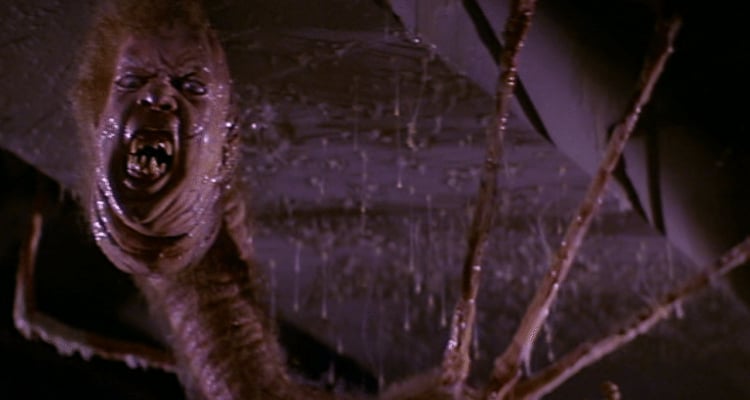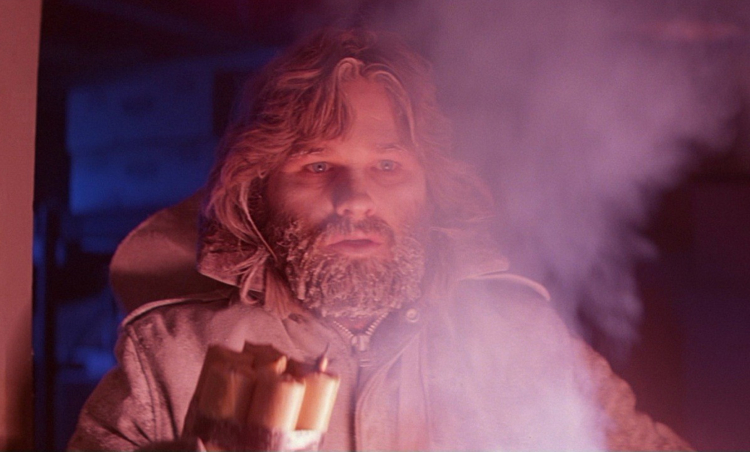The Thing Turns 35 | A Tribute to the Sci-Fi/Horror Masterpiece
The Thing is now a byword for sci-fi/horror par excellence, one that can sit proudly among body horrors such as Alien, The Fly, Videodrome, Invasion of the Body Snatchers and others. But it wasn’t always so. Released today in 1982, The Thing was a complete failure both financially and critically. Reviewers hated it and audiences flocked to see two other films released a few weeks earlier, namely Tobe Hooper’s Poltergeist and Steven Spielberg’s ET: The Extra Terrestrial. Factor in the release of Blade Runner, Tron and Star Trek II: The Wrath of Khan in the summer weeks after The Thing, and Carpenter’s dark, claustrophobic sci-fi horror got lost in a season full of sci-fi big budget epics, some that have weathered the storm of time quite well and some that have not.
Where the bread and butter of American cinema in the 1970’s had been paranoia thrillers (The Parallax View, The Conversation, All The President’s Men etc), the 1980’s had a far more optimistic, popcorn kind of feel to it hence when ET and The Thing went toe to toe in the summer of ’82, there was only going to be one winner. In 1982 audiences did not want to see a gruesome alien as a big budget studio film and ironically when Carpenter made his family friendly alien film Starman in 1984, all that the theatre going audiences wanted to watch was the cold-blooded The Terminator. Vincent Canby, writing for The New York Times, described The Thing as:
“a foolish, depressing, overproduced movie that mixes horror with science fiction to make something that is fun as neither one thing or the other. Sometimes it looks as if it aspired to be the quintessential moron movie of the 80s.”
Harsh words for something that is now deemed to be a classic. Carpenter himself said:
“I take every failure hard. The one I took the hardest was The Thing. My career would have been different if that had been a big hit…The movie was hated. Even by science-fiction fans. They thought that I had betrayed some kind of trust.”
I think I speak for most film fans when I say that Vincent Canby was talking out of his ass – The Thing is a masterpiece.
What I love about The Thing is the claustrophobia and the paranoia… and Kurt Russell’s beard! No one rocks a face full of hair as well as Russell, except maybe Michael J. Fox in Teen Wolf. Why Alien worked so well in ’79 is reflected in The Thing too, namely the sense of isolation and the nerve jangling tension. Just like Ripley and co needed to use their own initiative to beat the alien in Ridley Scott’s classic, the rag tag bunch of scientists and doctors and ancillary workers stationed in the middle of Antarctica need to save themselves, there is no deus ex machina to bail them out.
But, unlike Alien, the sense of pessimism is total and absolute and this may well have been the element of the narrative that audiences just could not swallow or take to. From the moment the thing of the title attacks the sled dogs and Blair realises that the resultant steaming mess of limbs and fur and organs is not dead and displays the creatures ability to assimilate its host perfectly, then these men have no hope and no future. With The Thing’s version of the all-knowing computer Mother simulating the probability of mankind’s extinction if the creature escapes the confines of the Antarctic Blair sabotages the communications and the transport. They can’t get out and they can’t get help in. MacReady knows that Blair has stranded them in Antarctica and virtually condemned them to die. Yet they don’t give up, the men are doing everything they can to stay alive and to kill the creature, as futile as it may be.
The cast is also uniformly excellent – Kurt Russell, A. Wilford Brimley, Keith David, Donald Moffat, Richard Masur, Richard Dysart, Charles Hallahan and the other members of the Antarctic project are just superb. There’s not a dud performance among them, each creating a believable character, one that deals with this situation in their own way, be that Keith David’s bully as Childs, Hallahan’s nervous Norris or Brimley’s calculating Blair. It is a masterclass in how to act in an ensemble. Our hero is MacReady and he trusts no-one. In The Thing there are no allies and this only heightens the sense of paranoia and isolation. MacReady assumes the mantle of leader once Norris and Doc Copper die, but it is an uncomfortable fit for him. Child’s is his natural nemesis, the one member of the crew who wants control and both enjoy a few face-offs, none as powerful as the final scene.
When it came to practical special effects there really are only three people capable of making something grotesque and beautiful and brilliant all at the same time, those men are Stan Winston, Rick Baker and Rob Bottin. Even today those three are considered the touchstone of practical visual effects (even though we lost Stan Winston a few years ago). Rob Bottin was 20 years old when John Carpenter asked him to make the creature for The Thing and it took him a year of 7-day weeks, 14-hour days to get the job done. And boy what a job did he do. Anyone who speaks of The Thing never gets too far into the conversation before the creature is mentioned, before Norris’s death and the chest chomp sequence is brought up. As in-camera effects go it is one of the greatest ever filmed, much like Baker’s werewolf transformation sequence in An American Werewolf in London. Not only does it look amazing – Norris’s neck elongating, his face contorted in agony as his body parts start to separate – it is also truly terrifying. As the audience watches the head slide down the side of the steel table to the floor we don’t expect what comes next – the head sprouting spider legs and walking away. Never once does the audience stop and say, “wait a minute, that’s an effect!”. So real is Bottin’s work that Charles Hallahan, who played Norris, said during the filming of his death sequence that cast and crew members were so convinced that his fake chest was real that they kept putting blankets over him so he wouldn’t get cold even though the only part of him on that table was his head, the rest of the body on display was a prosthetic.

With a film so dark and so heavy, humour also became very important. This is something Carpenter gets absolutely spot on and paces to perfection. The humour (and believe me when I say there is not much of it) is not driven by funny lines or pithy comments but through a sense of character or how the character expressed a thought. A prime example is Palmer. In the aftermath of Norris’s death and his unveiling as the creature, as his six-legged head scurries away, Palmer looks around at a fellow stunned colleague and says “you gotta be fucking kidding!” It’s not what he said, but how he said it and how that one line of dialogue diffused such a full-on scene. Or take the testing scene, where MacReady and Nauls and Windows have the remaining survivors tied to a sofa in the rec room testing their blood. The sense of tension is palpable, the paranoia and distrust ratcheting up as each man is either proven to be human or alien. Garry is the last man left and after passing the test he utters this immortal line of dialogue: “I know you gentlemen have been through a lot, but when you find the time, I’d rather not spend the rest of this winter TIED TO THIS FUCKING COUCH!” His delivery makes it what it needed to be, the antidote to the gut churning uncertainty that coated every single action in that scene. Spoken softly and slowly and with great restraint, he roars the last five words and it’s that change of tone that can’t help but raise a chuckle. It’s very human, it’s very real.
I was once told that the sign of a good score is when you can’t actually remember hearing it once the film is over, the logic being that the music does not get in the way of or detract from the images. With The Thing we have an Ennio Morricone masterpiece, as subtle an example of film scoring as you are likely to see and one terrifyingly haunting. Morricone’s wonderful bass and synth heavy score underpins everything in the movie, the “heartbeat” theme tune is almost as iconic as John William’s simple theme to Jaws. Where Carpenter worked hard to create the isolation on screen, Morricone captured perfectly the sense of foreboding and paranoia in one of his less obvious scores. According to legend, Morricone tried to imitate the scoring of other Carpenter films, each scored by Carpenter himself, and maybe that is why the maestro with a wealth of sonic beauty to his palette opted for this minimalist score that spoke of the hopelessness of those trapped in the snow. Though rightly lauded for his spaghetti westerns, The Thing could quite easily be the finest score Morricone ever produced.

One other simple and often missed element of The Thing’s narrative structure is the breaking of the film into chapters. If you watch the film again you will notice the fade in and fade out between the various segments of the film, using whiteout’s during the day and blackout’s during the night. On a totally subconscious level the viewer is drawn into The Thing step by step, each fade out working like a cliff hanger and creating a sense of anticipation for what comes next. The emphasis on finding the alien craft and the alien body or Blair’s realisation that the alien has more than likely infected the crew is accentuated by the clever editing and blocking of the chapters of the film. The red herring’s and unanswered questions are also a neat plot device – when was Blair infected?, who owns the torn pair of long johns?, what becomes of MacReady’s tapes? who sabotaged the blood? All these unanswered questions work as a hook and keeps the audience looking for answers in everything on screen.
And now the ending – very few films can get away with an ending like The Thing. It is both brazenly optimistic and totally pessimistic at the same time. If you want to think that Childs and MacReady live, then you can. If you want to think that they die, then you can. If you want to think that one of them is the alien, then you can. It is the most frustratingly satisfying endings ever committed to celluloid and I am delighted that no clear indication was given to what happened to both MacReady and Childs. Film lore goes that Carpenter did film an alternative ending, where help arrives but ditched it as he wasn’t being honest with either the characters or the audience by showing what became of Childs or MacReady. For me they are frozen out there in the wastes of Antarctica, just waiting to be found. Just waiting to be thawed. Just waiting…
Man is the warmest place to hide, you know.

